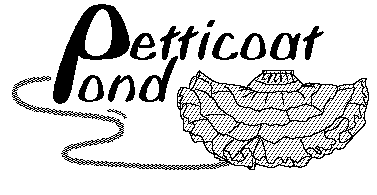

REWIND
THE FIFTIES ©1997-2005
by Peggy Epstein
Fifties Fashion -
Crinolines
The Full Skirt Becomes Fuller . . . and Fuller Yet: Those Crucial Crinolines
It’s 1956 and you’re a sixteen-year old fashion princess waiting to board the city bus for a trip to downtown Omaha. You’re fresh-faced and meticulously neat, but as you hand over your fifteen-cent fare and turn around, you see people nervously sliding over to the aisle seat, making it clear you’re not welcome. What’s wrong with you? Why does no one want to share a seat? The answer is not malicious prejudice, but rather what can be found beneath your new pink cotton full skirt, where you are sporting not one, not even two, but three 'starchy' crinolines. You find a seat and sit down, carefully tucking your skirt behind you, and then quickly flinging your hands over your knees, just in time to keep the skirt from bouncing toward the ceiling of the bus and revealing your underwear. But as soon as you’ve got your knees covered, the skirt springs up on both sides, one side flying into the face of the rider in the window seat. You apologize, and work feverishly to contain yourself on one half of a bus seat. How did we come to this?
In the late 40’s, when Dior came up with what some called “The New Look,” the small waists his line featured were accentuated by extremely full skirts, made from as many as 25 yards of fabric. All that skirt needed some support to hold it out away from the body, further accenting the waist. That’s where crinolines came in. Made from netting or paper nylon, the starched, stiff gathered petticoats, provided the lift needed to flare out those skirts. Lingerie departments bulged as space was added for huge assortments in a variety of colors and styles. In a 1955 ad in the Kansas City Star, Kline’s department store offered (for $2.99) “Petti Pretty, our newest nylon can-can: a gay rainbow fluff of nylon net below a glamorous knit torso.” The New York Macy’s the same year was selling a three-tiered powder blue crinoline, and at Neusteder’s in Denver, you could buy a pristine white net petticoat bordered on the bottom by a band of multi-colored embroidery.
Although crinolines were natural underpinnings for a net formal, at some point, the style reached beyond the elegant for-evening-only gowns and was adopted by teenage girls for everyday dress. And this is where our young lady comes in. At last she has reached her destination: Brandeis Department Store, where she heads for the lingerie department on the third floor. Her object: a new crinoline, of course. The selections are numerous, but she is looking for something in particular. She has repeatedly, as everyone recommends, subjected her crinolines to repeated washings in sugar water, swishing them around in the bathtub, wringing them out gently and lying them out to dry over umbrellas on the basement (where once a village of ants thought they’d found Utopia). Now her crinolines have become limp, but she knows just the thing to take care of that problem. Yesterday, in the privacy of the restroom on the landing of the girls’ stairs at Central High School, Judy Anderson from her fourth hour algebra class showed off a new hoop petticoat. Its ribbons were laced with stiff nylon “bones.” At last, a crinoline that wouldn’t wear out. And there was no question as to which of her petticoats she would give up in exchange for the new one. She would simply add it to the others, wearing it on the third layer, one of her older crinolines on top to smooth over the bones. Bus riders, beware.
ABOUT THE AUTHOR: Peggy Epstein is a retired English teacher and a free-lance writer. Her book "Great Ideas for Grandkids" was published by McGraw-Hill. Her articles have appeared in the Kansas City Star, College Bound, Footsteps, Grit, Teaching Tolerance, and others.